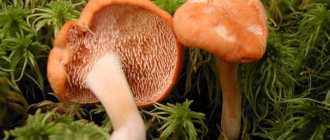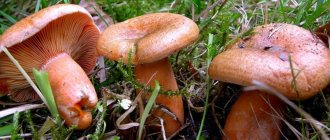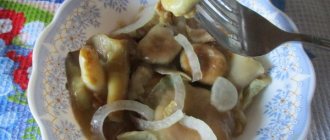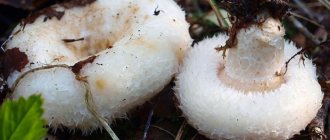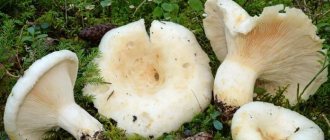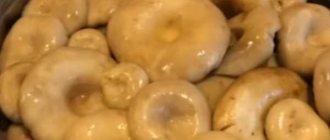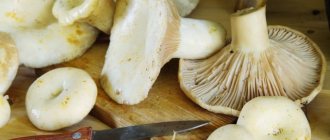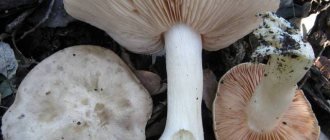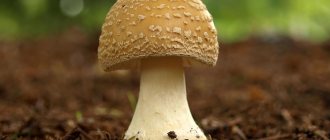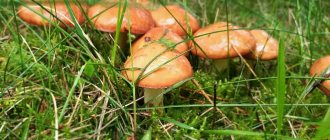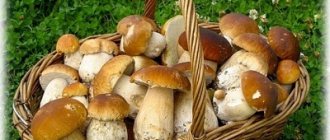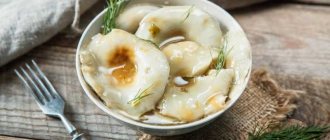White milk mushroom is highly valued among lovers because of its taste. It also has other names - raw milk mushroom, real and pravsky. For many foreign tourists, this mushroom is closely associated with a real “Russian” mushroom. White milk mushroom grows in spruce and pine forests; it can also be found in birch groves. It is found in large colonies, which is why it got its name – “milk mushroom”. To find it, you need to look carefully under the foliage, where it hides from view. This article will discuss the main features of white milk mushroom, where to look for it and at what time you can harvest the largest possible harvest.
White milk mushroom.
Description of white milk mushroom
An experienced mushroom picker knows what a white mushroom looks like. It is quite difficult to confuse it with others. White mushroom (raw, real) is very highly valued among our mushroom pickers, sometimes even more than white mushroom. White mushrooms are found on Uloma Zheleznaya much less often than porcini mushrooms, because they love calcareous clay soil, and our soils are mostly sandy and peat. If you can meet other mushrooms by chance, then with White Mushroom you can’t do without knowing the mushroom places.
| Group: | Lamellar |
| Color: | Whitish, with a yellowish tint. |
| Peculiarities: | with milky juice |
| Department: | Basidiomycota (Basidiomycetes) |
| Sub-department: | Agaricomycotina (Agaricomycetes) |
| Class: | Agaricomycetes (Agaricomycetes) |
| Subclass: | Incertae sedis (uncertain position) |
| Order: | Russulales |
| Family: | Russulaceae (Russulaceae) |
| Genus: | Lactarius (Millary) |
| View: | Lactarius resimus (True milk mushroom) |
In Western books, the white milk mushroom is called a low-value mushroom. The cool attitude of foreigners can only be explained by the fact that they simply do not know how to salt milk mushrooms correctly. There are many white milkers. A distinctive feature of the White Milk Milk is its fluffiness and moisture, especially when young. The fur can be very thick. The leg has spots characteristic of milk mushrooms. This is clearly visible in our photographs. Another important identifying feature is the rapidly yellowing milky juice. White milk mushrooms grow to large sizes (20-25 cm in diameter).
In adulthood, the fluff dries out and the top of the cap may become yellowish. Much depends on wet or dry weather. It was the white milky juice of milk mushrooms, as well as the frequent white plates on the underside of the cap, that determined their belonging to the genus of mushrooms Lactarius - from the Latin “milk” of the Russulaceae family. Of all the milk mushrooms, the most valuable species is the real milk mushroom (Lactarius resimus), which is often called “white milk mushroom” or simply “milk milk.” In various localities, the white milk mushroom is known as the raw milk mushroom, the wet milk mushroom, or the pravskiy milk mushroom.
How to collect milk mushrooms.
There is no exact information about the origin of the name “mushroom” itself, but in our understanding the word is associated with something heavy and massive, which is the adult mushroom itself. It is also believed that the word is derived from the Old Slavonic “grud” (growing on a pile), or from “gruzdno” (to grow in a heap, in large groups), according to another version - from the Lithuanian “gruzdny” (fragile, brittle). The real milk mushroom, or white milk mushroom, belongs to the edible lamellar mushrooms. It is most common in the northern and northwestern regions of the European part of Russia, as well as in the Volga region, Siberia, and the Urals. White milk mushroom grows in deciduous and mixed forests, mainly under birch trees, forming large groups under them. The fungus spends most of its time underground, and only at an average daily temperature of + 8-10 °C does the fruiting body of the fungus appear on the soil surface.
In the Moscow region, white milk mushroom is considered an autumn fruit. The white milk mushroom is large. It has a flat-convex cap of white, milky or yellowish color with a diameter of more than 5 cm. In adult mushrooms, the cap takes the shape of a funnel with the edges turned inward and grows up to 20 cm in diameter. On the underside of the cap there are wide plates of white or cream color, with yellowish edges. The leg of the milk mushroom is colored the same color as its cap. It is cylindrical in shape, low, and in old mushrooms it is hollow. Sometimes yellow spots or pits are visible on the leg.
The flesh of the milk mushroom is white, dense, with a specific smell. The white milky juice contained in it is caustic and in air gradually acquires a sulfur-yellow color. Pre-soaking or boiling mushrooms helps get rid of bitterness. As the milk mushroom grows, particles of soil, blades of grass, leaves, and twigs stick to its slimy wet cap. This makes young mushrooms sometimes difficult to notice in the autumn forest. And milk mushrooms do not favor light; they hide from it under the foliage. Knowing this, experienced mushroom pickers go for mushrooms with a stick. Having seen a large old milk mushroom, they will definitely use it to rake off the foliage from the protruding tubercles nearby; perhaps young milk mushrooms are hiding there.
What does a white breast look like?
Some common lookalikes
Milk mushrooms and other conditionally edible mushrooms of this family are not poisonous, but not very pleasant to the taste buds. People preparatory process the mushrooms, then cook them. The milk mushrooms are soaked and boiled for a long time with salt.
Pepper milk mushroom
The fruiting body of the mushroom is creamy-white; in mature specimens, the cap has the shape of a funnel with many gills. When pressed, it bleeds whitish milk with a peppery taste. Widely distributed in Europe, the Black Sea region in northeastern Turkey, eastern North America, and introduced to Australia. Forms a symbiotic relationship with deciduous trees, including beech and hazel, and grows in the soil from summer to early winter.
Mycologists consider it inedible and poisonous; culinary experts do not recommend it because of its taste. In its raw form, difficult to digest. In folk practice, it is used as a seasoning after drying, boiled, fried in butter, pickled, baked in dough.
The mushroom is prized in Russia. People harvest pepper milk mushrooms during the dry season, when other edible mushrooms are less available. In Finland, cooks boil mushrooms many times and drain the water. The latter is stored in chilled salted water all winter, pickled or served in salads.
Eating fresh and raw mushrooms irritates the lips and tongue; the reaction goes away within an hour.
Camphor milkweed (camphor milkweed)
They appreciate it for its smell. Cooks use it as a spice, not for cooking. The size of the camphor milkweed is small to medium, the cap is less than 5 cm in diameter. Color ranges from orange to orange-red and brown. The shape of the cap is convex in young specimens, flat and slightly depressed in mature mushrooms.
The fruiting body is fragile and brittle, secretes a whitish and watery-looking milk, similar to whey or skim milk. The juice has a mild or slightly sweet taste, but is not bitter or acrid. The smell of the mushroom has been compared to maple syrup, camphor, curry, fenugreek, and burnt sugar. The aroma is weak in fresh samples, becoming strong when the fruit body dries out.
Dried mushrooms are ground into powder or infused in hot milk. Some people use L. camphoratus to make a smoking mixture.
Violin (felt weight)
This is a fairly large mushroom found near beech trees. The fruiting body is dense, non-fibrous, and when damaged, the fungus releases colostrum. Mature specimens have caps from white to cream color, funnel-shaped, up to 25 cm in diameter. The wide stem is shorter than the fruiting body. The gills are distant from each other, narrow, with brown spots from dried juice. The spore print is white.
The mushroom is collected in deciduous forests from late summer to early winter. Milk juice has a neutral taste on its own, but is spicy if consumed with pulp. In the West, felt milk mushroom is considered inedible due to its pungent taste. In Russia, before cooking, they soak for a long time, then salt.
Golden-yellow milkweed (golden milkweed)
It is pale in color, poisonous, and grows in symbiosis with oak trees. The cap is 3–8 cm across, with dark markings of rough rings or stripes. At first it is convex, but later smoothes out; in older specimens there is a small central depression, the edges are without lint.
Popular articles Sansevieria flower - types and varieties, description
The whitish or pale yellow stalk is hollow, cylindrical or slightly swollen, sometimes pinkish on the lower half. The gills of the hymenophore are frequent, straight, with a pinkish tint, the spores are white-cream.
The whitish pulp has a pungent taste and is colored with abundantly secreted milk. Colostrum is initially white, but after a few seconds it turns bright sulfur yellow.
Golden milkweed appears in summer and autumn in the northern temperate zones of Europe, North America and North Africa.
Consumption results in predominantly acute, severe gastrointestinal symptoms.
Where to collect milk mushrooms
You can meet milk mushrooms both in deciduous and mixed forests of Belarus and Russia. In Russia, they grow mainly in the northern parts, the Middle and Upper Volga regions, western Siberia, and the Urals, but in the south it is almost impossible to see them. If you don’t yet know where to collect milk mushrooms, look into birch forests and forests mixed with birch trees. Most often you can find real milk mushrooms there. Also, such mushrooms grow in pine-birch forests and with linden undergrowth. You can also meet them in oak and aspen groves.
Milk mushrooms prefer black soil, with rotting leaves, moist soil. You are unlikely to find them on sandy soil, since it does not retain moisture. You should look for milk mushrooms in the shade of trees, especially under birch trees, near stumps and in clearings with short grass. But keep in mind that such mushrooms are well “camouflaged.” Therefore, when looking for them, always pay attention to the mounds formed by fallen leaves. To avoid constantly bending down to check every suspicious place, you should find a strong twig and use it to push back the raised leaves.
When you find one mushroom, you don’t need to leave immediately, it’s better to look around, it is likely that you will be able to find many more mushrooms, since milk mushrooms often grow not individually, but in whole groups.
However, you need to know not only where, but also when to collect milk mushrooms. Each type of these mushrooms has its own fruiting period, but they are mainly collected from the end of July to September. Milk mushrooms grow best after frequent, but not too heavy rains. Of course, such mushrooms also appear after heavy rainfall, but they disappear very quickly. In summer, in dry weather, you will not be able to find milk mushrooms. It is best to collect them in early autumn, when dew falls on the grass in the morning.
White milk mushroom in a section.
Gorchak
Description
More similar to boletus, sometimes it is confused with boletus.
It is inedible because no measures can remove the bitter, nasty taste. If at least one representative gets into the soup, the dish will be spoiled irrevocably.
The bitterness does not break down during heat treatment, but is enhanced many times over.
If a specimen was found near a rotten stump and was never bitten by anyone, despite its impressive size, then rest assured that it is a bitterling.
How is it different from milk mushrooms?
It does not look like milk mushroom at all; it is impossible to confuse it with agaric mushrooms.
Externally, it slightly matches the white one: it is also stocky, stands confidently on a strong thick leg, the inside of the cap is spongy.
You can distinguish it only by taste. It is enough to lightly lick the edge - if you feel bitterness, you should immediately rinse your mouth and throw the mushroom away.
Also pay attention to the stem on the cut: in bitterling it turns pink
Classification of white milk mushroom
Milk mushroom belongs to the genus of mushrooms, under the general name Lactarius (Latin) from the very large family of Russula (Latin Russulaceae) and the order of the same name Russula (Latin Russulales). Well, the Latin name of this genus, translated into Russian, means “milk” or “milk-giving.” Since ancient times, people have called the most valuable species of this genus (such as the real milk mushroom) milk mushrooms. And in our time, many species of this genus are called milk mushrooms, including inedible ones (such as gray-pink milkweed). And this name is accepted for most species of the genus Lacticaria (except perhaps for saffron milk caps and saffron milk caps). And “dry milk mushrooms” or podgruzdki (more precisely, podgrudki) are no longer called milkweeds, but some types of russula (lat. Russula), however, included in the same family.
The word “gruzd” comes from the Proto-Slavic gruzdъ, which is related to the word “heap” and the expected internal form of the word with this etymology is “growing on a pile (on a heap).” However, according to another version, the word “mushroom” comes from the adjective gruzd (th): (from the Latin gruzdus - “heavy mushroom” - “fragile or brittle mushroom”). And according to the third version, the word “milk mushrooms” means mushrooms that grow “heavy”, that is, in a heap or in large groups.
In Russian mycological literature, since the beginning of the 19th century, the “real” milk mushroom has always been considered the species now called pepper milk mushroom (lat. Lactarius piperatus). And only in 1942, the Soviet scientist, researcher of the Russian Arctic and mycologist of cap mushrooms - B. P. Vasilkov (1906 - 1980) showed that the popular name “real milk mushroom” actually refers to white milk mushroom (lat. Lactarius resimus).
Cap of white milk mushroom.
External characteristics and description of the mushroom
The fleshy body has a unique taste and smell. Also, the edible violin mushroom has the following distinctive features:
hat
- The structure is fleshy, dryish, with a felt surface, creaks when in contact with other objects
- The diameter of the cap changes during the ripening of the mushroom from 5 to 26 cm
- During the period of growing up, the shape of the cap changes from flat, or slightly protruding towards the center with low sides, to funnel-shaped with cracked edges
- The color changes its palette from milky to more saturated with a tint of ocher and interspersed with yellow spots
Hymenophore (lower part of the fleshy body)
- Has a plastic look
- Rare plates 3-8 mm wide are located along the area of the hymenium and have a greenish-cream tint, which later hang down on the stem of the mushroom. With age they acquire a yellowish tint
- The controversial material is spiky, white in color
Skripnitsa mushroom is almost like milk mushroom, only healthier
Pulp
- Bitter to taste, hard, brittle and easily crumbles when pressed
- Milky juice is released. Reacting with air it turns yellow and when it dries it turns reddish brown.
Other types
In total, about 120 different species are known in the genus of milkweeds, about 90 of which live in Russia and the former republics of the Soviet Union. And who, if not the Slavs, should not know these mushrooms, because from time immemorial they were considered originally “Russian”. And under the general name of mushrooms, a very large group of mushrooms is now known; of the light (white) milk mushrooms, it includes:
- milk mushroom yellow (pitted);
- blue milk mushroom (blue yellow);
- milk mushroom fringed (shaggy);
- milk mushroom aspen (poplar);
- oak milk mushroom (mystery mushroom);
- parchment mushroom (parchment-pepper);
- bluish milk mushroom (bluish-pepper);
- pepper milk mushroom (spicy);
- felt milk mushroom (violin);
- dry milk mushroom (white milk mushroom),
and among the dark (black) milk mushrooms it includes:
- black milk mushroom (nigella);
- black podgruzdok (black russula).
The only difference in their structure lies only in the details or their coloring, but in general they are all very similar to each other and sometimes it is very, very difficult to distinguish them. One of the advantages of milk mushrooms (except for milk mushrooms) is the fact that due to the presence of caustic milky juice in their pulp (which milk mushrooms are almost completely devoid of), they are extremely rarely affected by mushroom worms.
Different types of milk mushrooms.
Black breast
Black milk mushroom grows in large friendly circles, often in a birch forest, less often in a mixed forest, from July to October. Prefers slopes of hollows and wet lowlands. His hat is almost flat, depressed in the middle, with tucked edges; with age, the edges straighten and rise up. The diameter of the cap is from 3 to 20 centimeters. The color is olive-black, in old mushrooms it is black. The plates are narrow, dirty white, and later with brown spots. The stem is short, dense at first, then hollow, the color of the cap or a little lighter. The pulp is dense, light white, with a faint odor.
At the break it darkens a little and secretes an acrid, watery-white juice. Having collected the mushrooms, they must first be soaked for two to three days in salted water, changing it twice a day. Milk mushrooms are very tasty when salted, but they can also be pickled. Salted black milk mushrooms take on a dark cherry color. Its flesh remains grayish-white. It tastes like white milk mushroom, but is inferior in aroma.
The breast is black.
White poplar mushroom
In oak plantings, under poplars on river banks, and on islands, white poplar milk mushrooms grow in large groups. It resembles the real white one, but unlike it, it has a very weak mushroom smell and does not have a fluffy fringe on the cap. Its milky juice is white, caustic, and turns yellow in the air. In all other respects, it is an exact copy of a real milk mushroom. There is, however, one more difference - no matter how much you soak it, it still tastes a little bitter.
White poplar mushroom.
White loader
It can be found in mixed forests, where pine and oak predominate. You won't see him in a wet hollow or on top of a hillock. It prefers shallow, dry lowlands. It grows very densely. From one mycelium you can collect two or three buckets of these beautiful mushrooms. In shape, color and smell, the white milk mushroom is no different from the white real milk mushroom. The differences are that it does not have a fringe on the edges of the cap, does not exude milky juice when cut, and its flesh is sweetish. The plates of white podgruzdka contain a slight acrid bitterness. These aromatic mushrooms can be salted, marinated and fried. There is no need to soak them. The white mushroom and the listed milk mushrooms do not have poisonous counterparts.
White loader.
Blue breast (Lactarius glaucescens)
The bluish milk mushroom is very similar to the violin milk and the pepper milk milk, sometimes even described as a form of the pepper milk milk Lactarius piperatus var. glaucescens. It is distinguished by its white milky juice, which gradually coagulates in air and becomes grayish-greenish when dried. The cap of the mushroom is white, velvety, dry, and with age creamy spots and cracks appear. The plates of the mushroom are very frequent, matching the cap or creamy.
The breast is bluish.
Some authors describe the smell of the mushroom as follows: “if you want to recognize this mushroom by smell, it may remind you of the smell of fresh sawdust, rye bread or a faint honey aroma.”
In terms of edibility, the bluish milk mushroom is similar to its twin brothers: the violin milk mushroom and the pepper milk mushroom. Moreover, after cooking, the mushroom takes on an unappetizing bluish appearance.
Pepper milkweed (Lactarius piperatus)
A close relative of the violinist, very similar to her. The pepper milk mushroom lives in broad-leaved (especially oak) and mixed forests. The violin is somewhat less common. It differs from the skipapa in the smooth, non-velvety surface of the cap, on which brownish spots appear in old mushrooms. In addition, the milky juice of this milk mushroom becomes greenish, gray-green or bluish when exposed to air. You can also distinguish them by their plates: in the violin they are much rarer, but this is visible only in adult mushrooms. Young milk mushrooms cannot be distinguished, although who needs this? Pepper milk mushrooms aren't as woody as violin mushrooms, but no matter what you do with them, you can't eat them. Although, it is possible - but only if there is nothing else at all.
Pepper milk.
Blue breast or dog breast (Lactarius repraesentaneus)
It grows under birch and willow in damp places of deciduous, coniferous and mixed forests in late July-August in single specimens or groups. His hat is yellowish, with protruding hairs, and shaggy at the edges. The flesh of the blue milk mushroom is white, dense, and bitter. The smell is pleasant. The milky sap is white, but turns purple in air. The plates are frequent, narrow, running down the stem, pale yellow. The spore powder is yellowish. The leg is up to 7 cm long and up to 3 cm thick, pale yellow, with spots, loose inside, hollow when ripe, turns blue when touched. Dog milk mushroom is conditionally edible, second category. Used only in salted form.
The breast is blue.
Yellow breast
Another name is yellow pod (Lactarius scrobiculatus). It grows in birch, less often in coniferous forests, in July-September, sometimes in very large groups. The cap is up to 20 cm in diameter, fleshy, dense, moist, in wet weather slimy, sticky, initially rounded-convex, then spread out, funnel-shaped, with a furry edge turned down. The surface of the cap is golden-yellow, with faintly defined dark concentric zones.
Additional material: Beneficial properties and uses of birch chaga mushroom
The flesh of the mushroom is white, turning yellow when touched. When cut, a white milky juice is released, which turns yellow in the air (does not change in rainy weather). The yellow milk mushroom plates descend along the stem, whitish or cream. The spore powder is yellowish. The leg is short, 4-5 cm long, up to 3 cm thick, narrowed downwards, pale yellow with dark spots, mucous. Yellow breast milk is conditionally edible and belongs to the first category. It is mainly used for pickling and pickling.
The breast is yellow.
Milk breast golden yellow
The plates are faded, yellow-orange, large, sparse, adherent to the stalk or slightly descending. Spore powder is pale ocher. The leg is the same color as the cap, full and fleshy in youth, hollow in old age. The pulp is white, with a bitter white milky juice, which in a few seconds can turn sulfur-yellow. There is no smell. The taste is delicate at first, but then the bitterness becomes stronger and stronger. In summer and autumn it grows mainly under oak trees. Tasteless.
What is the difference between a milk mushroom and a spruce row?
Grows on sandy soil in coniferous, mainly pine forests from August until autumn frosts, singly and in small groups. Distributed everywhere, but quite rare. The cap is up to 10 cm in diameter, fibrous, mucous-sticky, initially flat-convex, then semi-prostrate, light gray to dark gray in color, often with a yellowish or purple tint, darker in the center than along the edge, with radial dark stripes .
The most important thing that distinguishes milk mushroom from spruce row is that its flesh is not brittle, white, does not turn yellow in the air, has a faint smell of flour, and tastes fresh. The plates are white, then light yellow or bluish-grayish, sparse, wide. The leg is up to 10 cm long and up to 2 cm thick, smooth, white, then yellowish or grayish, fibrous, sits deep in the soil. The mushroom is edible, category four. Used boiled, fried, salted and pickled.
How to collect milk mushrooms
An important point is the peculiarity of collecting milk mushrooms. More precisely, do not confuse the milk mushroom with the common milkweed or camphor milkweed. Common milkweed differs from milk mushrooms in its spicy aroma. Eating it can cause stomach upset and vomiting. If the lacticaria is dried and ground into powder, it can be used as a spice. During drying, the toxic substances that make up the mushroom are destroyed.
Camphor milkweed also has a strong odor, and it smells like camphor. It is absolutely inedible and should not be collected under any circumstances.
Symptoms of poisoning and first aid
Typically, the first indicators of mushroom poisoning appear 1.5–2 hours after eating them.
The person begins to feel:
- nausea and vomiting;
- weakening of the pulse;
- temperature increase;
- painful inflammatory sensations in the abdomen;
- cooling of the extremities.
This is followed by frequent diarrhea. The pain does not go away, it is very strong. The first necessary actions when signs of poisoning appear are:
- Call a doctor immediately.
- Maintain bed rest.
- Drink plenty of water or cool, strong tea.
- Take activated carbon.
Never forget that all mushrooms can only be collected in environmentally friendly areas. Collecting milk mushrooms and other forest products requires not only good theoretical knowledge (description, taking into account the main differences and the presence of pronounced characteristics), but also experience. Nutrients and vitamins, original forest taste and aroma are positive and important characteristics of mushrooms. But there are also dangerous aspects: toxicity and improper processing.
How to distinguish white milk mushroom
There are mushrooms that look like white mushrooms. It can be distinguished by a number of characteristic features. How to learn to easily and accurately distinguish between “white milk mushrooms”? It is quite difficult to confuse a white (or real) breast with others; its cap always has a very shaggy (fluffy) edge, which completely gives it away. And in order to distinguish the remaining white milk mushrooms, you must first of all pay attention to the color tone of their plates. The aspen (poplar) milk mushroom has pinkish plates, the cap is often decorated with pink concentric circles, and its milky juice is white, abundant and pungent, and does not change its color.
If there is no pinkishness, then you need to check the rusty spots, which also occur on aspen (poplar) milk mushrooms or pepper milk mushrooms, and whether their flesh turns yellow at the break and cut. If it turns yellow, it means it is a felt milk mushroom (violin), moreover, its cap is sometimes covered with light white fluff, which is still not always possible to see. If the milky juice turns green when scraped, then the mushroom is parchment or bluish. If neither the pulp nor the milky juice changes color and the juice is not liquid, but thick, very viscous, then it is a pepper milk mushroom. And if there is no milky juice at all on the scrap, then it is a white load.
How to distinguish white milk mushroom.
It is worth paying attention to the place where milk mushrooms are collected. The white milk mushroom grows next to the birch and is found in deciduous or mixed forests with linden undergrowth, and with it the parchment milk mushroom and the bluish milk mushroom grow. Yellow milkweed grows near coniferous trees (spruce, fir), but sometimes (this is an exception) and next to deciduous trees (birch). The oak milk mushroom grows in forests with broad-leaved trees (oak, beech, hornbeam), and the pepper milk mushroom likes to settle next to it.
Aspen (poplar) milkweed always grows under aspens, willows, and poplars, preferring plantings along roads. White Podgruzdok can grow successfully not only in deciduous, but also in mixed forests with a predominance of aspen and poplar, but it grows especially well near wild forest apple and pear trees, or along the banks of large rivers on turf-sandy soil. Paying attention to the indicated signs, it will not be difficult to understand the white milk mushrooms.
Interesting read: What kind of mushroom is the goat mushroom, how to find it and when to collect it
Chemical composition of white milk mushroom
In terms of the chemical composition of milk mushrooms, the presence of the following components can be noted:
- Squirrels,
- Fats,
- Vitamins E, B, C, D, PP and A;
- Polysaccharides;
- Potassium, calcium, phosphorus;
- Fiber, etc.
Habitat
As a rule, milk mushrooms grow in groups, at a distance of several meters from each other. If you come across one mushroom, carefully examine the clearing; most likely its “brothers” are hidden under the foliage nearby.
Milk mushrooms are found throughout the Russian Federation and prefer mixed or deciduous forests. The peak of mycelium development and harvest ripening occurs in autumn; the duration of fruiting depends on the region and the climatic characteristics of the region.
Let's devote a few words to the rarer brother of the mushroom we are considering - the black milk mushroom. If you see a plant identical in shape, but different in brown color, in a deciduous thicket or pine forest, it may be an edible black milk mushroom. You can verify this by smelling the fruit, as well as lightly pressing on its flesh - if the surface is darkened and the aroma is pleasant, feel free to collect the delicacy you find.
Application of white milk mushroom
Due to their taste, milk mushrooms have been honored and respected in Rus' from time immemorial. Perhaps, in Russian cuisine, milk mushrooms are the most famous and beloved mushrooms. And in Siberia, people have been collecting and eating milk mushrooms exclusively for several centuries. By the way, milk mushroom is the only mushroom that has a place in Russian proverbs: “If you call yourself a milk mushroom, get into the back!”
Real milk mushrooms are used for pickling (they require soaking in advance). Ready-made salted milk mushrooms have a bluish tint and a special aroma, for which they are loved. To cook milk mushrooms, they are first soaked in cold water for 3 hours to a couple of days, changing the water several times. They cook for no more than 15-20 minutes.
False milk mushrooms.
How to salt a violin at home
In search of the simplest, but at the same time delicious method of cooking, many people like to experiment with spices and various additives. You can choose dry, hot or cold preservation method. For a spicy, spicy taste, you can add garlic and pepper.
Hot marinating violin with currant leaves
Hot salting methods are usually very simple. And also, with this method of preservation, the duration of soaking mushrooms is reduced to two days. Many people neglect soaking, which as a result affects the taste of violins - they turn out with a bitter aftertaste. If you follow the recipe, this can be easily avoided. Ingredients:
- 1 kilogram of milk mushrooms;
- 30 grams of table salt;
- fresh currant leaves;
- filtered water.
How to prepare: prepare the main ingredient - sort and rinse thoroughly. Place in a bowl of water and soak for two days, changing the water several times. Then transfer them to an enamel bowl and boil the mushrooms. Add salt to the water. Simmer for 20 minutes, skim off foam periodically. Place in a colander and let all the liquid drain. Cool the main component.
Place fresh currant leaves in jars, and place the milk mushrooms with their caps on the bottom. Each new tier should be sprinkled with salt. Compact the milk mushrooms and place the currant leaves last. Place in a cool place to infuse. After a month you can use it.
How to salt skripukhi in a cold way
This method of preservation is in many ways similar to hot pickling of mushrooms. The cold method is also called the dry method, since no brine is prepared during the cooking process. If you do not follow the correct technology, the mushrooms will be unsuitable for consumption. Ingredients:
- 1 kilogram of squeaky mushrooms;
- 30 grams of salt;
- dill inflorescence;
- Bay leaf;
- allspice;
- 2 cloves of garlic;
- carnation.
How to prepare: clean and prepare the forest product - trim off spoiled areas, remove wormy mushrooms. Rinse and infuse the mushrooms in a bowl of filtered water for several days. Place the main component in a wooden container with the caps on the bottom. Add dill, garlic, bay leaf, pepper and cloves. Sprinkle with salt. Cover with a wide plate and put something heavy on top.
The creaks should be kept in this position for two days - this way they will release more liquid. If there is not enough water, you can pour in a little salt solution so that it completely covers the main ingredient.
How to marinate mushrooms with garlic
Marinated mushrooms with a garlic component are a spicy but at the same time savory appetizer for a holiday table or an addition to salads. This twist will acquire a pleasant aroma for the winter and become crispy. The effort and time spent are fully justified by this preparation with a special taste. Ingredients:
- 1 kilogram of milk mushrooms;
- liter of filtered water;
- fresh dill;
- currant leaves;
- allspice;
- 3 cloves of garlic;
- 4 tablespoons of salt.
How to prepare: rinse all ingredients. Prepare a container for marinating - a glass or wooden container is best. Aluminum or stainless steel containers are not suitable for this purpose. First, lay out the greens and allspice. Then a layer of creaks and garlic is laid out. Salt everything. After that comes another tier of herbs and garlic. Everything is covered with a wide plate and pressed down with something heavy. After a couple of days, the main component will settle and give a lot of juice. Move to a cool place and wait one month.
Useful properties of the mushroom
These mushrooms can not only be enjoyed for their great taste. Along with this, you also get huge benefits. The positive capabilities of milk mushrooms are manifested in the following:
- Acts as a diuretic;
- Helps remove kidney stones;
- The fungus contains components that destroy many pathogens;
- Able to overcome Koch's wand;
- Improves human immunity;
- Contribute to the activation of mental activity and memory;
- Stimulates digestion;
- Normalize the functioning of the nervous system;
- Control sugar levels;
- Clean the vessels;
- Helps cope with tuberculosis;
- Improve the general condition of an organism weakened after illness or injury;
- Have a positive effect on weight loss, fight against obesity;
- Remove warts;
- Improves the condition of skin, hair and so on.
The main value of milk mushrooms is their high protein content. These mushrooms contain even more of it than beef and chicken. Moreover, the protein contained in them is absorbed by the body very well. In addition, milk mushrooms are rich in thiamine, ascorbic acid and riboflavin. They are also the only non-animal product containing vitamin D. This property of milk mushrooms can be very useful for vegetarians. At the same time, milk mushrooms perfectly saturate and give a long-lasting feeling of satiety.
Another advantage of milk mushrooms is that they do not lead to an increase in glucose levels. Therefore, diabetics can eat them without fear. Those wishing to lose weight are also recommended to consume aspen, yellow, black or white milk mushrooms. The benefit of mushrooms in this case lies in their ability to remove toxins, and due to their diuretic effect, excess fluid.
Chemical composition of milk mushrooms.
Their regular consumption has a beneficial effect on the nervous system. With the help of such mushrooms you can prevent depression and nervousness, and reduce the likelihood of stress. Milk mushrooms also help in the treatment of certain diseases. Most often, traditional medicine uses them for diseases such as urolithiasis, cholelithiasis, and emphysema. Milk milk can have an antibacterial effect, so it is recommended to consume them during the epidemic season. These wonderful mushrooms strengthen the mucous membranes of the bronchi and lungs and prevent Koch bacilli from multiplying.
That is why pepper milk mushrooms, the benefits of which are recognized even by official pharmaceuticals, are used to make drugs for tuberculosis. Milk mushrooms have another valuable property because they contain biologically active substances that can prevent the formation of uric acid salts in the kidneys. Thanks to this, such mushrooms can be used in the treatment of kidney stones. To remove stones, traditional medicine experts recommend consuming milk mushrooms slightly fried. It is worth including them in the diet during ischemia; in this case, it is recommended to eat one hundred grams of mushrooms per day.
Separately, it is worth noting the benefits of salted milk mushrooms. After undergoing the fermentation process, they acquire high enzymatic activity, anti-sclerotic and anti-inflammatory properties. Thanks to this, such milk mushrooms improve the functioning of the gastrointestinal tract and cleanse blood vessels. It is recommended to consume them on average 250 grams three times a week.
What does a white breast look like?
Useful qualities, contraindications
The chemical composition of the mushrooms we are considering can give a head start to healthy fish or hearty meat. The pulp of the delicacy is literally oversaturated with a huge amount of minerals and other useful substances, namely:
- Vitamins of groups BB, C, D.
- Phosphorus, potassium, calcium.
- Ascorbic acid, carotene.
- Magnesium, sodium, phosphorus.
If we consider the product from the point of view of BZHU, the fruiting bodies are saturated with proteins, carbohydrates, and also protein, which is easily absorbed by the human body.
Each product has certain benefits or harm to the human body. Let's note the positive effect that white milk mushroom has on health:
- Strengthens the immune system and gives vitality.
- Stabilizes the functioning of the central nervous system.
- Improves blood circulation and regulates the functioning of the cardiovascular system.
- Strengthens hair, nails, bones.
- Can serve as an antibacterial agent.
- Prevents infection with tuberculosis.
- Reduces blood cholesterol levels.
- Facilitates the course of kidney diseases.
White milk mushroom is widely popular among representatives of traditional medicine, as all kinds of tinctures, extracts and pickles are prepared on its basis.
As for contraindications, of course, they also exist. People suffering from problems with the gastrointestinal tract should treat this treat with caution. As you know, any mushroom is considered a heavy food, which means it can cause indigestion or even intoxication.
The same rule should be followed by those whose liver and pancreas periodically fail. Another group of people in the “risk zone” are elderly, weakened citizens, pregnant or nursing mothers, and small children with weak digestion.
Those whose medical records contain diseases such as renal failure, hypertension, and gastritis should also limit themselves in eating milk mushrooms.
Allergy sufferers and those whose bodies have been found to be individually intolerant to certain components of natural gifts should pay particular attention to the product.
This is where the restrictions end. Remember, any product is useful if you use it in moderation.
Harm and contraindications of milk mushrooms
Milk mushrooms, unlike well-known champignons, which can be eaten even raw, are conditionally edible mushrooms. Of course, this does not mean that they are poisonous, just that they must be properly processed before cooking. After collecting milk mushrooms, you must soak them for two to three days, and it is advisable to change the water three times or at least twice a day. For soaking, you can use clean cold or salted water. As a result of this treatment, the bitterness will go away from the mushrooms and all toxic substances will be removed. After this, it is recommended to boil them for about twenty minutes, and then cook them at your own discretion.
Milk mushrooms, the benefits and harms of which have already been well studied today, are not recommended by experts to be consumed in case of acute inflammation of the gastrointestinal tract; they should be avoided in case of liver diseases, gastrointestinal ulcers, and pancreatitis. Since milk mushrooms, like any other mushrooms, are considered a rather “heavy” food, gastritis is also a contraindication to their use, especially in the acute stage, eating disorders, as well as children under six years of age. Milk mushrooms can cause harm if they are collected near busy roads and in polluted areas, since they have the ability to accumulate harmful substances from the outside.
Material on the topic: Mushrooms in the Moscow region in 2022: the best places and collection season
Differences between black milk mushroom and pig milk
Svinushka, a genus of lamellar mushrooms. The difference between a pig and a milk mushroom is that it has a cap with a diameter of up to 20 cm, initially convex, then flat, funnel-shaped, with an edge turned inward, velvety, yellow-brown, sometimes with an olive tint. The flesh is light brown, darkening when cut. The plates are decurrent, connected at the bottom by transverse veins, and are easily separated from the cap. Leg length up to 9 cm, central or shifted to the side, narrowed downwards, the same color as the cap. The mushroom grows in forests of various types, in large groups, from July to October, and can form mycorrhiza. It is imperative to know the difference between black milk mushroom and pig mushroom, since in recent years pig mushroom has been classified as a poisonous mushroom (it can cause poisoning, even fatal). It contains substances that lead to a decrease in red blood cells in the blood. Moreover, the manifestation of poisoning depends on the individual characteristics of the human body and can occur either a few hours later or several years after consuming these mushrooms. The fat pig is distinguished by its larger size and dark brown velvety leg. Forms mycorrhiza or settles on wood. Conditionally edible. Pig animals have the ability to accumulate harmful compounds of heavy metals.
Pickling mushrooms
There are several ways to get white milk mushrooms.
Classic recipe
Soak the mushrooms in water, adding a little citric acid and salt. Let it sit for two days, but change the water every morning and every evening. Now place the mushrooms in a glass jar. There should be a little salt at the bottom of the container (a thin layer). Milk mushrooms are placed with their caps down. Sprinkle salt on top. Please note that 1 kg of product contains about 45 grams of salt. When the jar is full, cover it with a cloth. Place a circle on top and place a weight on it.
After a couple of days, juice from the mushrooms will appear and they will thicken. This will allow you to add more milk mushrooms to the jar. Do this until the mushrooms stop settling. Do not remove the load. Upon completion of the mushrooms, they should be in brine. If it is not enough, add some boiled water with a small amount of salt. The product is salted for 1-1.5 months in a cold place.
Pickling mushrooms.
Quick salting
To do this, the mushrooms are soaked for a day and then peeled. Fill with cold water and cook for 20 minutes after the water boils. Now add black pepper (peas), a little salt, bay leaves, maybe cloves. This will result in a flavorful brine. Let cool, add vegetable oil and chopped onion. Best served with potatoes.
Dry milk mushrooms in cooking
Dry milk mushrooms are consumed:
- in pickled form;
- in salted form.
Before cooking, the milk mushrooms (dry milk mushrooms) are soaked in cold water for 5 hours. Then they are boiled in salt water. Then place it in cold water again.
Salt in 2 ways:
- Quick: dry milk mushrooms are boiled for 20 minutes, adding salt and spices to taste. Add citric acid or vinegar to prevent the product from fermenting. Place the mushrooms in a bowl of cold water to cool. After 10-15 minutes they will be ready to eat.
- For long-term storage: place the mushrooms in several layers in a container suitable for this purpose. If you take an enamel container, it should not have chips in the enamel. Each layer is salted and finally filled with water. The product is left under water and moved to a place at room temperature. When foam stops forming, the product is washed. The mushrooms are placed in containers (jars) and filled with salt water. Storage conditions: cold place. A refrigerator or cellar is suitable.
Cook for up to 20 minutes, constantly skimming off the foam. Next, the mass is dried and placed either in jars, bags, or special containers. Store in the freezer for up to 10 months.
Caviar from loads
- mushrooms - 2 kg;
- carrots - 0.5 kg;
- onion - 0.5 kg;
- pepper;
- salt;
- vinegar 6% - 5 tbsp. l.;
- vegetable oil.
Initially, the vegetables are peeled, washed and ground. They are fried in a frying pan with vegetable oil and poured into a saucepan to simmer.
The loads are finely chopped or used in a meat grinder. The mixture is poured into the vegetables, and 0.5 tbsp is added. l. vegetable oil, simmer for 40 minutes, stirring occasionally.
Add spices and simmer for another 10 minutes. At the end, add vinegar, stir and immediately pour the mixture into jars. Roll up, allow to cool and move to a cool, dark place.
Marinated mushrooms in tomato
To prepare you will need the following ingredients:
- water - 500 ml;
- bay leaf - 2 pcs.;
- vinegar - 2 tbsp. l.;
- spices - to taste;
- garlic - 2-3 cloves;
- vegetable oil;
- tomato juice, or paste, or ketchup - 250-350 g;
- mushrooms - 1.5 kg.
The main product is fried, ketchup, tomato paste or juice, water are added, and mixed. Next add spices and garlic passed through a press. Laurel leaves are thrown. Simmer for 0.5 hours, then add vinegar. Simmer for another 10 minutes, remove the bay leaves from the container. The mass is distributed into sterilized jars, leaving a free space of 1.5 cm from the neck of the jar. Sterilize 0.5 liter jars for 40 minutes, 1 liter jars for 1 hour and then roll them up. The cooled dish is transferred to a cool and dark place.
Growing white milk mushroom
Milk mushrooms are quite tasty mushrooms, especially in pickles. Therefore, recently, in addition to growing the well-known champignons and oyster mushrooms, amateur gardeners have begun to breed milk mushrooms. The principle of breeding milk mushrooms is to place the mycelium of the fungus in the prepared substrate and after a year over the next 5 years you can harvest. This is the first method - it is simpler and more reliable. The second is to collect mushroom spores and develop the mycelium independently.
This method is not always effective, since there is no guarantee that the milk mushroom mycelium will develop correctly. Otherwise, the cultivation of milk mushrooms would have been carried out on a production scale for a long time. However, if you are an experienced mushroom grower, then this method of breeding milk mushrooms is within your power. Growing milk mushrooms begins with acquiring high-quality mycelium. In addition, you will need a hardwood tree that is no more than 4 years old. The best “companions” for milk mushrooms are birch, poplar, willow, and hazel. It is necessary to prepare soil with a high peat content.
Prepared and pre-treated (sterilized) sawdust, but straw or husks can be used instead. You need to take care in advance of small pieces of moss, which is better to cut off in those places where milk mushrooms usually grow. It is also advisable to have a small amount of harvested fallen leaves.
The substrate must be prepared in advance, since there is no guarantee that the mycelium will take root safely, although it is known which trees the milk mushrooms coexist with well. To prepare the substrate, disinfected soil is mixed with sterilized, steamed sawdust. Then dig 3 small holes (20 cm deep and 10 cm in diameter) next to the tree, closer to the roots.
However, the procedure for planting mycelium should be done extremely carefully so as not to damage the root system. Fill the holes halfway with the prepared substrate. Place pieces of mycelium on top. Place a little more substrate on top of the mycelium, compacting tightly. Prepare a lime solution for watering at the rate of 50 grams of lime per 10 liters of water. Each place should receive at least 1 liter of water. This procedure helps disinfect the soil. The holes are covered with moss and fallen leaves.
Growing white milk mushroom.
Snack
If you can’t imagine any feast without a mushroom appetizer, pay attention to the method of canning salted milk mushrooms. The recipe is based on the presence of five kilograms of the fruits we are considering. In addition to mushrooms, you will need: 180-200 grams of salt, peppercorns, dill, fresh garlic (not granules), bay leaf, vinegar, spices to taste and fresh currant leaves. Step-by-step instruction:
- Boil or prepare pre-soaked fresh milk mushrooms.
- Work on the brine according to the calculations: per liter of liquid there are 1.5 tablespoons of salt, 5 tablespoons of vinegar with a sharpness of 5 percent, spices, seasonings and leaves to taste (some gourmets add a few teaspoons of sugar).
- As soon as the brine is ready, you need to place the mushrooms in it and leave the preparation to infuse for 30 days.
- Has the specified period of time passed? Rinse the mushrooms, prepare the brine again (a “softer” one is possible), place the fruiting bodies in jars, and fill them with brine and set them to sterilize. After 50-70 minutes, the jars can be rolled up with lids.
Pickled
Some gourmets do not remain indifferent to pickled mushrooms. The following recipe will tell you how to prepare this dish:
- Take 2.5 kilograms of forest products, wash them, cut them into small pieces and boil in boiling water for 3-5 minutes.
- Drain the excess liquid using a colander, place the product in a suitable container, add 100 grams of salt and 150 grams of sugar to the mushrooms.
- Stir the fruits so that the salt and sugar are evenly distributed over all the pieces. Press down with pressure to get rid of excess air.
- Pour in 200 ml of sour milk.
The cooking time at room temperature is 14-16 days. If you plan to prepare the delicacy for future use, you can fill it with salty brine, place it in jars and sterilize it.
For lovers of black milk mushrooms, we also have one classic pickling recipe.
Five kilograms of forest fruits are soaked, cut, placed in jars and seasoned with salt (20 grams per liter jar). Sprigs of fresh or dried dill, several cloves of garlic, black peppercorns and a few blackcurrant leaves are also added there. The resulting mixture is poured with hot liquid and sterilized for 1 hour. After this, the jars can be rolled up and eaten after 35-45 days.
Now let's move on to how to distinguish milk mushrooms from other mushroom crops, for this we will consider the most similar forest gifts.
Places of distribution and time of collection
Under thin aspen trees, according to its eloquent name, aspen mushrooms , forming neat clearings, not far from one another, fused together in the form of chain links. It likes to settle near the root system of poplars of various types, often growing in poplar plantations and forest belts. The collection time is only two months long - August and September.
The bright yellow milk mushroom has taken a liking to spruce forests - small close groups of these mushrooms grow under the thick paws of dark spruce trees; less often, it forms entire clearings. Harvesting occurs in late summer and early autumn.
Oak milk mushroom grows in numerous families in oak forests, prefers soft calcareous soils, and settles in abundance on the slopes of warm, sun-warmed hills. Tight greenish fruiting bodies of this species are found from late summer until frost.
Individually or in large groups, black milk mushrooms . It is collected by carefully cutting off the short stem during the period of mass offering - from mid-July to the end of summer.
White Podgruzdok grows singly or in clearings in oak groves, birch and mixed forests. The collection begins in mid-summer and lasts until September.
Mushrooms similar to white podgrudok
The greenish platelet pod is very similar and is often confused with the white pod. They are distinguished by a turquoise stripe where the gills are attached to the cap and an unpleasant, pungent odor.
Loader greenish-platelike
Skriptsa secretes a bitter milk, which insects do not like, so wormy fungi do not occur. The milky juice makes this mushroom conditionally edible, but not poisonous.
Places where black russula grows.
Mostly black russula grow in pine forests. They live in groups. Nigella grows under pine trees. Fruiting of nigella is observed from July to October. Black russula are common in mixed, deciduous forests and conifers.
Evaluating the edibility of nigella.
Black russula are edible, but they are not very tasty; they are classified in the 4th category. During salting they turn black. Their taste is sweetish and pleasant. They are also boiled and stewed. It is recommended to soak the russula before cooking. These mushrooms go well with fried and stewed vegetables. And salted russula are considered a delicacy. Salted russula are ready within 24 hours. They go well with other types of mushrooms.
Fried russula is not inferior in taste to many other types. Black podgrudki can be served as a separate dish or with side dishes. Some connoisseurs prepare chops from them. But it is not recommended to add russula to soups, as they give the dish a bitter taste.
Properties and benefits of black loads.
Black russula contains vitamins B2 and PP, as well as carbohydrates, fats and proteins. These mushrooms have an antibacterial effect. The calorie content of black russula is low, so they are suitable for dietary nutrition, but at the same time they are nutritious and satisfies the feeling of hunger well without creating discomfort in the stomach.
Russula is indicated for people with gastrointestinal diseases. They help with blood thickening and prevent the risk of developing blood clots. In addition, russula curdles milk, creating a healing fermented milk product from it. This product is useful for people with cardiovascular diseases.
Related species.
Russula rosea is a conditionally edible relative of the black russula. Her hat is semi-circular in shape. Its surface is smooth, dry, velvety. The color of the cap can be dark pink or red. The leg is cylindrical, thick, white with a pink tint. The pulp is dense but fragile.
Rose russulas grow in deciduous forests and are rarely found in coniferous forests. These mushrooms can settle in mountainous regions. Fruiting of pink russula is observed in summer and autumn.
Russula Turkish is an edible mushroom. The shape of the cap can be convex, flattened or depressed. Its color is most often lilac, but can be gray-violet. The leg can be cylindrical or club-shaped, white or pink. The pulp is dense, white, with a sweetish taste and pleasant smell.
These mushrooms grow in coniferous European forests. Turkish russulas live under spruce and fir trees. They grow singly or in small groups.
Loads
Milk mushrooms, as already mentioned, belong to the group of milkweeds. That is, when they break, they always secrete milky juice. But the loads do not release such juice either at the break or at the cut. But in shape and appearance they are exactly the same.
White loader (cracker)
The cracker lives up to its name one hundred percent. His hat is dry, rough, matte white, and does not have any mesh fringe along the edge. The mushroom remains dry even when broken, although it has a characteristic mushroom smell.
The size of the cap, like that of real milk mushrooms, can reach 20 cm in diameter. At first the cap is flat, then it becomes funnel-shaped and turns yellow. What makes the cracker similar to a real milk mushroom are the brownish spots that appear on the cap. The plates are bluish-white. The pulp is white, dense, sweetish taste, does not change color when broken.
White podgrudok (Russula delica)
Inexperienced mushroom pickers often confuse mushroom pickers with real mushrooms. This mistake is also possible because the cracker, like its real brother, hides from the eyes of the mushroom picker under the forest floor. And it’s not easy to find a young seedling, because the fruiting body of the cracker begins to form underground.
White podgruzdok is very tasty when salted. Some people prefer to eat it by boiling it in salted water, hot, with sour cream. You can also fry it, and it’s better not alone, but in company with other mushrooms.
Loader black
Another representative of milk mushrooms is the black milk mushroom. Its cap, from 5 to 15 cm in diameter, is first convex, and then depressed in the middle and funnel-shaped. In young mushrooms it is dirty gray, in adults it is brown or dark brown. The skin of the cap is slightly sticky to the touch and cannot be removed. The pulp is initially white, brittle, then brownish-gray, turns red when broken, and then turns black. The descending plates are whitish, grayish with age, and turn black when pressed. The leg is cylindrical, solid, smooth, the same color as the cap, and also darkens when pressed.
Black podgrudok (Ruussula aduusta)
Podgrudok black is a category III mushroom. It can be consumed fresh, salted, but always after preliminary boiling. It is not very popular among mushroom pickers due to its rather low taste, as it has a peculiar smell of damp earth.
Source
Who should not eat milk mushrooms?
This is a heavy meal if a person has problems with the pancreas, liver and gall. Wild milk mushrooms are not given to children under 7 years of age or to pregnant women. Frequent consumption of milk mushrooms containing active substances increases the body's sensitivity and exacerbates allergic reactions.
Cooking milk mushrooms, especially conditionally edible ones, without following technology is harmful to the functioning of the gastrointestinal tract and the functioning of the excretory organs. Spicy, salty and sour mushrooms are contraindicated for hypertensive patients and people with nephrosis. Occasional consumption of small portions of milk mushrooms is allowed.
Hot salting
- Rinse the mushrooms of debris and soak in clean, cold water for at least 6 hours.
- Boil the fruiting bodies in boiling water (15-20 minutes) over low heat.
- Drain off excess liquid, place the product in a colander and wait until the water drains as much as possible.
- Determine an appropriately sized storage container. It is necessary to transfer the mushrooms into it, and then sprinkle them with spices and a sufficient amount of salt.
- Next, the dish is covered with a plate or cloth and pressed down with pressure.
All that remains is to put the vessel in the refrigerator or a cool place. After two weeks, the snack will be ready, and during this period it is recommended to stir the contents of the container every few days.
In which forest do milk mushrooms grow, how many days after the rain do they appear?
spruce mushroom growing in a coniferous forest
Milk mushrooms love deciduous and mixed forests growing on black soil, rich in humus from fallen leaves.
Feel free to go looking for them if there are forests and undergrowth of the following trees near you:
- birch
- aspen
- pine
- Linden
- oak
- fir
- spruce
If the weather has been dry for a long time, and then it rains, go for milk mushrooms after 5 days. However, there is an opinion that the optimal period for their growth after rain is 12-15 days.
Edible qualities of white loading
Some people find it tasty even when eaten raw, others find the mushroom to be edible but unpleasant, with a poor taste. In Cyprus, the Greek Islands, Russia, Ukraine and other countries, huge quantities of Russula delica are collected and consumed every year. People marinate mushrooms in oil, vinegar or brine after boiling for a long time.
Another feature that limits its use in cooking is the difficulty of cleaning; the caps are almost always dirty, so you have to clean them and wash them thoroughly. In addition, this mushroom appears in the forest when it is still warm, and insects lay larvae in it.
Nutritional value of milk mushrooms
100 g of raw mushroom contains:
- protein - 1.8 g;
- fats - 0.8 g;
- carbohydrates - 1.1 g;
- fiber - 1.5;
- ash - 0.4 g;
- water - 88 g.
The energy value of 100 g of mushroom is only 18.8 kcal.
Mushrooms are rich in B vitamins - thiamine (B1), riboflavin (B2), ascorbic acid (C), and contain a small concentration of nicotinic acid (vitamin PP). But in terms of mineral composition, milk mushrooms occupy the last position among other mushrooms, since they practically do not contain macro- and microelements.
Curious facts
- Until 1942, the so-called pepper milk mushroom, Lactarius piperatus. Thanks to the research of mycologist B. Vasilkov, today scientists consider the species Lactarius resimus to be the real species.
- Milk mushrooms can be grown at home, but they require much more complex care than oyster mushrooms and champignons.
- Mushroom hunting for milk mushrooms can be done in Israel.
- Plant debris sticks more often to milk mushrooms than to other types of mushrooms.
- Eating pickled milk mushrooms promotes weight loss and balances blood sugar levels.
Taste assessment and cooking recipes
Officially, the blackening load belongs to the 4th category, that is, it is considered suitable only for salting. It is worth collecting it only at a young age - over time, the mushrooms become tough and often become wormy.
In addition to salting, loadings are also used boiled and fried. Below are the simplest recipes.
Primary processing
First, the mushrooms are soaked in water. This will take from 5 hours to a day. Sometimes it is recommended to soak the loads for 3–5 days, changing the water daily. With the liquid, the sharp taste of the cap will go away, and it will become much easier to clean the caps, to which leaves and needles usually stick. To expel worms that may have hidden in the mushroom and gone unnoticed, the water can be slightly salted.
Then the mushrooms are cleaned. Using a knife, remove the skin from the cap and remove all wormholes and areas that are in doubt - for example, yellowed ones. If stains are difficult to remove, use a clean toothbrush.
Frying
To prepare a delicious mushroom treat, take the following ingredients:
- 1 medium onion;
- 400–500 grams of mushrooms;
- butter or vegetable oil for frying;
- 1-2 cloves of garlic (to taste).
Cooking process:
- Finely chop the onion and fry in oil until translucent.
- Chop the boiled pork belly into slices and throw it into the frying pan with the onions.
- Fry for about 15 minutes, stirring so that the mushrooms do not burn.
- If desired, cut the garlic into thin slices or pass it through a press and add to the dish while frying.
